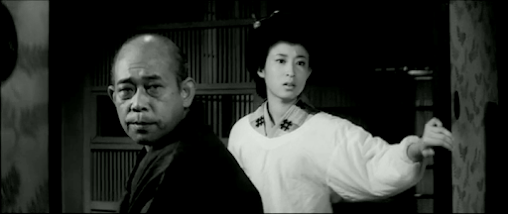Obscure Japanese Film #106
This Toei production stars Rentaro Mikuni as Miyoshi Sakata (1870-1946), an illiterate sandal-maker who went on to become the top player of shogi, a Japanese board game similar to chess. When we first meet him, he’s living by the railroad tracks in the Tennoji area of Osaka around 1900, and he’s so obsessed with shogi that he neglects his wife and children even when the family are struggling to get by. The only things that he can read are the characters on the shogi pieces.
He and his wife Koharu (Chikage Awashima) are followers of the Nichiren sect of Buddhism, but she is more devoted than he; in her despair, she frequently picks up an uchiwa taiko (fan drum) and chants namu-myoho-renge-kyo in an effort to improve their karma (the unhappy wife who seeks solace in this particular form of religion became something of a cliché in Japanese films and may well have originated in the 1947 play by Hideji Hojo upon which this film is based, although the real-life Sakata family were apparently not members of this sect).
After Sakata loses a game to Kinjiro Sekine (Mikijiro Hira) on a technicality, things get so bad that Koharu comes close to committing suicide on the railway tracks with their children. When her husband realises what he’s nearly driven her to, he throws his shogi board and pieces onto the tracks and vows to give up the game forever. However, shortly after this occurs, a couple of shogi enthusiasts (Taiji Tonoyama and Norio Hanazawa) arrive, announcing they have decided to sponsor Sakata, and his career resumes. As the years pass, he finds himself pitched against his arch-rival Sekine on a number of further occasions, and gradually becomes the leading shogi player in the country, improving his family’s financial situation in the process – but at what cost?

Taiji Tonoyama and Yoshiko Mita
This was director
Daisuke Ito’s third go at this story. His first had been in 1948 with
Tsumasaburo Bando in the lead, and his second in 1955 with Ryutaro Tatsumi (who
had originated the role on stage). The film opens with an impressive crane shot
of a bustling market lasting nearly two minutes and featuring hundreds of
extras (including Tetsuro Tanba as a candy floss seller at the very beginning!).
Ito is adept at the staging and blocking of scenes, and we are treated to some great camerawork throughout, while Akira Ifukube’s music is also effective. The sets are extremely well-designed and detailed, even featuring a convincing replica of the original Tsutentaku (a tower with neon lights) which overlooked Sakata’s neighbourhood from 1912-43. However, Ito’s weakness, in my opinion, lies in his direction of actors, and he frequently allows or perhaps encourages them to go over the top, a flaw which is certainly evident here.

Tsutentaku, Mikuni and Awashima
Rentaro Mikuni was a highly talented actor, but also an eccentric. In Osho, he gurns and whines his way through his performance, hacking up phlegm and affecting a grating, high-pitched voice. The fact that Sakata also gets physically violent with his grown-up daughter Tamae (Yoshiko Mita) when she tells him a few home truths means that he’s not only incredibly irritating, but entirely unsympathetic too, and in my view this is highly detrimental to the movie. Nevertheless, Mikuni seems to have had a hit in the role and appeared in a sequel (directed by Junya Sato) the following year (based on the play’s two sequels, I believe). It’s also worth noting that the real Sakata was said to have been a dandy rather than the scruffy slob portrayed here.
The rest of the cast are generally fine, though even Chikage Awashima overdoes it at one point. As Sekine, Mikijiro Hira’s role feels underwritten and he’s left with little to do – presumably this part was beefed up a bit for Tatsuya Nakadai when he played the role in Hiromichi Horikawa’s 1973 remake opposite Shintaro Katsu (which, unlike this version, has Sakata suffering from an eye disease as he did in real life, possibly because Katsu had a knack for playing the visually-impaired).
A young Sonny Chiba appears towards the end as one of Sakata’s disciples; the other is played by Hideo Murata, who had scored a huge hit a year earlier singing a song also entitled ‘Osho’ and concerning the life of Sakata (perhaps it was that success which had led to this version).
If only Ito could have reigned Mikuni in a bit, this film might have been a true classic.






No comments:
Post a Comment